 Technology peripherals
Technology peripherals
 AI
AI
 Is it really that silky smooth? Hinton's group proposed an instance segmentation framework based on large panoramic masks, which enables smooth switching of image and video scenes.
Is it really that silky smooth? Hinton's group proposed an instance segmentation framework based on large panoramic masks, which enables smooth switching of image and video scenes.
Is it really that silky smooth? Hinton's group proposed an instance segmentation framework based on large panoramic masks, which enables smooth switching of image and video scenes.
Panorama segmentation is a basic vision task that aims to assign semantic labels and instance labels to each pixel of an image. Semantic labels describe the category of each pixel (e.g. sky, vertical object, etc.), and instance labels provide a unique ID for each instance in the image (to distinguish different instances of the same category). This task combines semantic segmentation and instance segmentation to provide rich semantic information about the scene.
Although the categories of semantic labels are fixed a priori, the instance IDs assigned to objects in the image can be interchanged without affecting recognition. For example, swapping the instance IDs of two vehicles does not affect the results. Therefore, a neural network trained to predict instance IDs should be able to learn a one-to-many mapping from a single image to multiple instance ID assignments. Learning one-to-many mappings is challenging, and traditional methods often utilize multi-stage pipelines including object detection, segmentation, and merging multiple predictions. Recently, based on differentiable bipartite graph matching, some scholars have proposed end-to-end methods that can effectively convert one-to-many mapping into one-to-one mapping based on recognition matching. However, these methods still require customized architectures and specialized loss functions, as well as built-in inductive biases for panoramic segmentation tasks.
Recent general-purpose vision models, such as Pix2Seq, OFA, UViM, and Unified I/O, advocate general, task-unlimited frameworks to achieve generalization tasks while still being able to perform tasks better than before The model is much simpler. For example, Pix2Seq generates a series of semantically meaningful sequences based on images to complete some core visual tasks, and these models are based on Transformers to train autoregressive models.
In a new paper, researchers such as Ting Chen and Geoffrey Hinton of Google Brain follow the same concept and understand the panoramic segmentation task problem from the perspective of conditional discrete data generation.

##Paper link https://arxiv.org/pdf/2210.06366.pdf
As shown in Figure 1, the researcher designed a generative model for panoramic masks and generated a set of discrete tokens for each picture input to the model. Users can apply this model to video data (online data/streaming media) simply by using predictions from past frames as additional conditional signals. This way, the model automatically learns to track and segment objects.
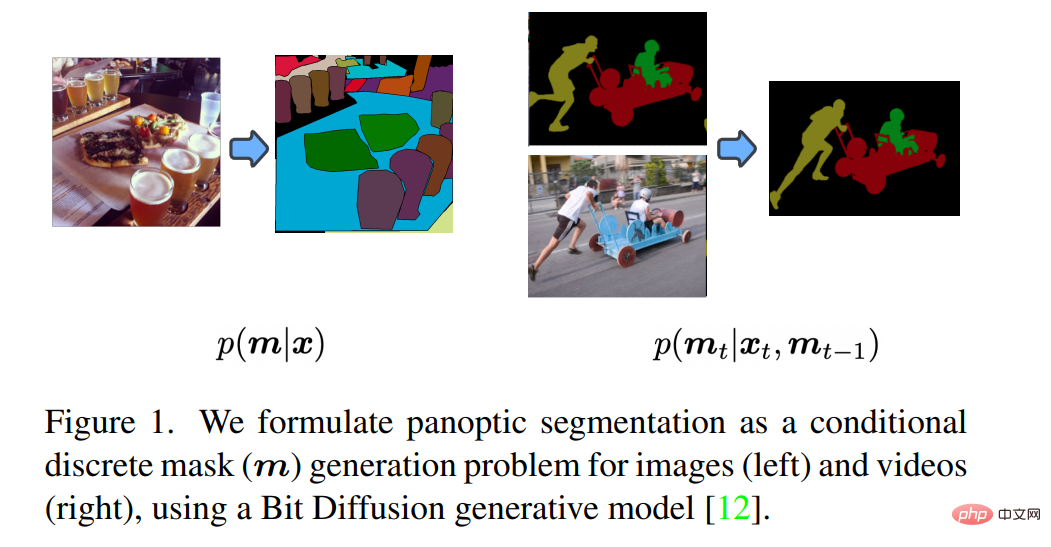
Generative modeling of panoramic segmentation is very challenging because panoramic masks are discrete, or categorical, and the model Probably very large. For example, to generate a 512×1024 panoramic mask, the model must generate over 1M discrete tags (semantic and instance labels). This is still relatively expensive for autoregressive models because tokens are sequential in nature and difficult to change as the scale of the input data changes. Diffusion models are better at handling high-dimensional data, but they are most often applied in continuous rather than discrete domains. By representing discrete data with analog bits, the authors show that diffusion models can be trained directly on large panoramic masks without the need to learn a latent space.
Through extensive experiments, the researchers demonstrated that their general method can compete with state-of-the-art expert methods in similar environments.
Model ArchitectureDiffusion model sampling is done iteratively, so forward propagation of the network must be run multiple times during inference. Therefore, as shown in Figure 2, the researchers intentionally split the network into two components: 1) image encoder; 2) mask decoder. The former maps raw pixel data to high-level representation vectors, and then the mask decoder iteratively reads out the panoramic mask.
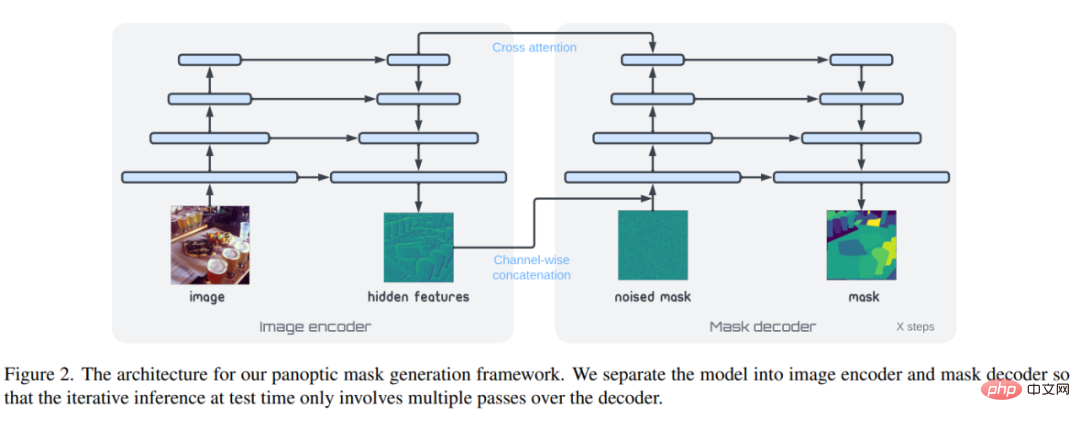
Pixel/Image Encoder
The encoder is a network that maps the original image  to the feature map in
to the feature map in  , where H' and w' are panoramic masks height and width. The panorama mask can be the same size as the original image or smaller. In this work, the researchers used ResNet as the backbone network and then used the encoder layer of Transformer as the feature extractor. In order to ensure that the output feature map has sufficient resolution and contains features of different scales, inspired by U-Net and feature pyramid network, the researchers used convolution with bilateral connections and upsampling operations to merge from different resolutions. feature. Although more complex encoders can be used, which can use some of the latest advances in architectural design, this is not the main focus of the network model, so the researchers just use simpler feature extractors to illustrate its role in the model.
, where H' and w' are panoramic masks height and width. The panorama mask can be the same size as the original image or smaller. In this work, the researchers used ResNet as the backbone network and then used the encoder layer of Transformer as the feature extractor. In order to ensure that the output feature map has sufficient resolution and contains features of different scales, inspired by U-Net and feature pyramid network, the researchers used convolution with bilateral connections and upsampling operations to merge from different resolutions. feature. Although more complex encoders can be used, which can use some of the latest advances in architectural design, this is not the main focus of the network model, so the researchers just use simpler feature extractors to illustrate its role in the model.
Mask decoder
The decoder is iteratively refined based on image features during model inference. Panoramic mask. Specifically, the mask decoder used by the researchers is TransUNet. The network takes as input the concatenation of an image feature map from the encoder and a noise mask (either randomly initialized or iteratively from the encoding process) and outputs an accurate prediction of the mask. One difference between the decoder and the standard U-Net architecture for image generation and image-to-image conversion is that the U-Net used in this paper uses a transformer decoder layer with a cross-attention layer on top before upsampling. to merge encoded image features.
Application in video mode
The researcher models the panoramic mask under image conditions as :p(m|x). Based on the three-dimensional mask of a given video (with an additional temporal dimension), our model can be directly applied to video panoramic segmentation. In order to adapt to online/streaming video settings, p(m_t|x_t,m_(t-1),m_(t-k)) modeling can be used instead to generate a new panorama based on the current image and the mask of the previous moment. mask. As shown in Figure 5, this change can be achieved by concatenating the past panoramic mask (m_(t-1),m_(t-k)) with the existing noise mask. Apart from this minor change, everything else is the same as the video base model (p(m|x)). This model is very simple and can be applied to video scenes by fine-tuning the image panorama model.
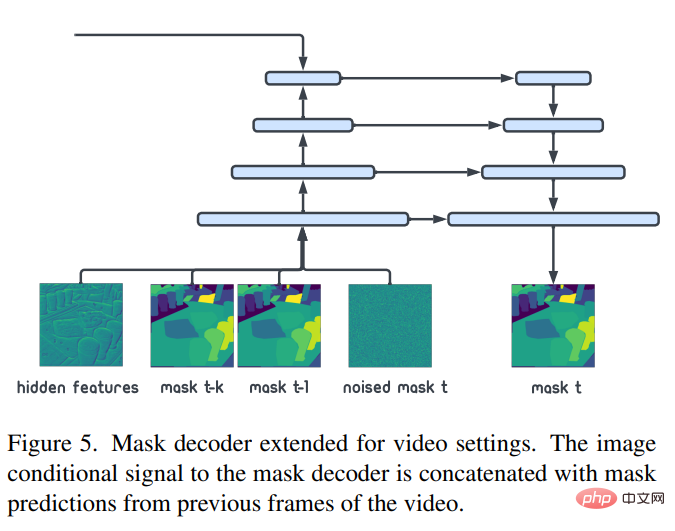
Experimental results
This paper compares with two series of state-of-the-art methods, namely expert methods and general methods. Table 1 summarizes the results on the MS-COCO dataset. The generalization quality (PQ) of Pix2Seq-D on the ResNet-50 based backbone is competitive with state-of-the-art methods. Compared with other recent general-purpose models such as UViM, our model performs significantly better while being more efficient.

Table 2 Compares Pix2Seq-D with state-of-the-art methods for unsupervised video object segmentation on the DAVIS dataset, using metrics Standard J&F. It is worth noting that the baseline does not include other general models since they are not directly applicable to the task. Our method achieves the same results as state-of-the-art methods without special design.
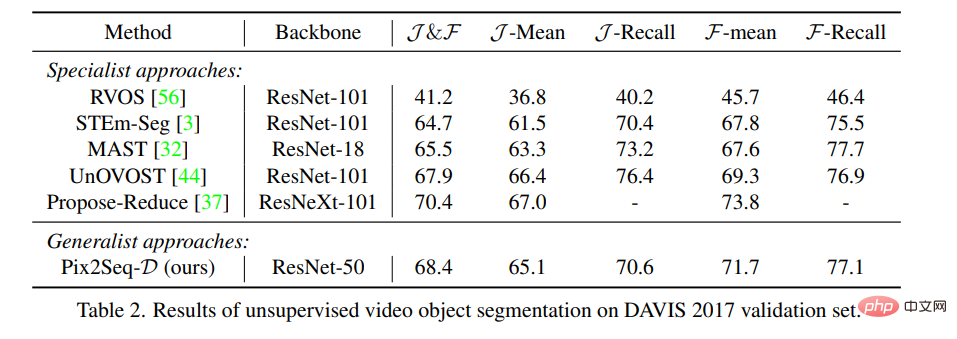
Figures 8, 9, and 10 show example results of Pix2Seq-D on MS-COCO, Cityscape, and DAVIS.
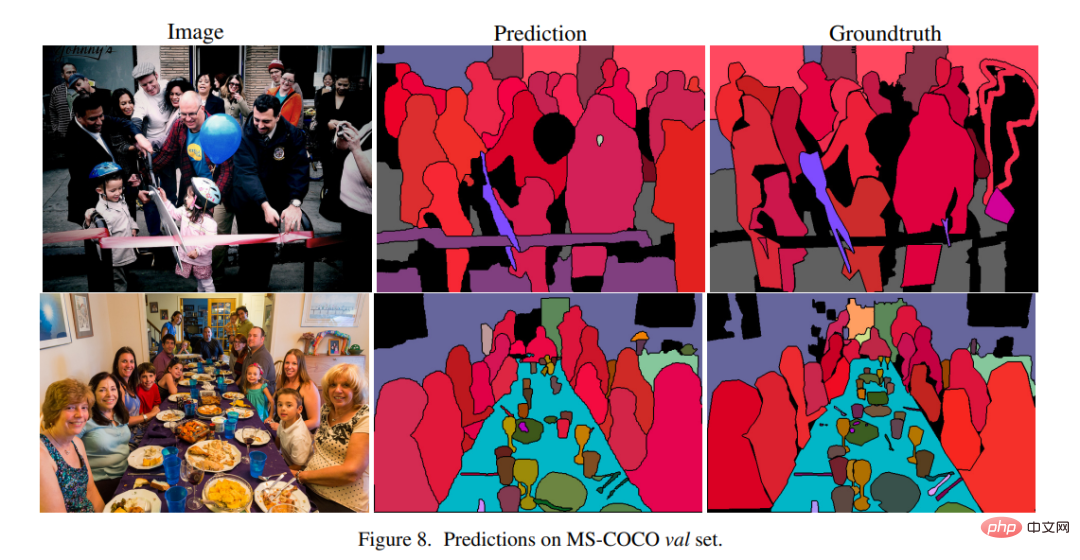
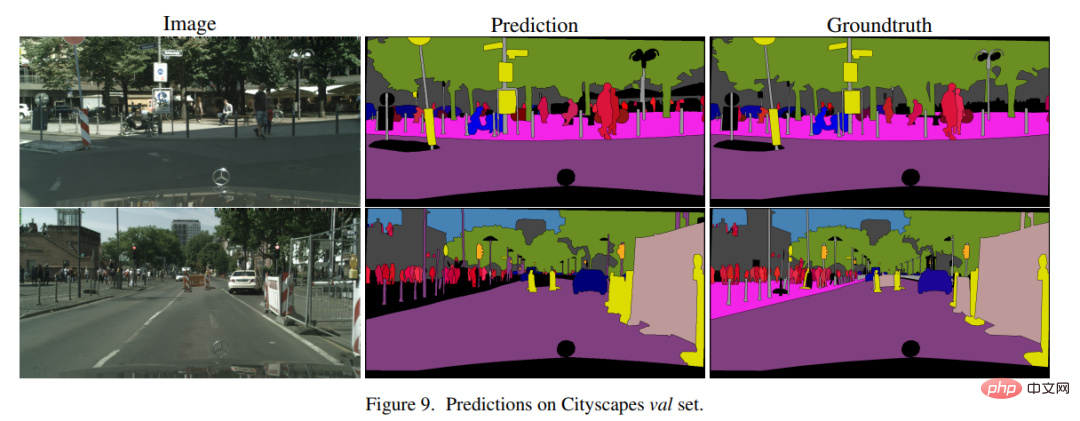

The above is the detailed content of Is it really that silky smooth? Hinton's group proposed an instance segmentation framework based on large panoramic masks, which enables smooth switching of image and video scenes.. For more information, please follow other related articles on the PHP Chinese website!

Hot AI Tools

Undresser.AI Undress
AI-powered app for creating realistic nude photos

AI Clothes Remover
Online AI tool for removing clothes from photos.

Undress AI Tool
Undress images for free

Clothoff.io
AI clothes remover

Video Face Swap
Swap faces in any video effortlessly with our completely free AI face swap tool!

Hot Article

Hot Tools

Notepad++7.3.1
Easy-to-use and free code editor

SublimeText3 Chinese version
Chinese version, very easy to use

Zend Studio 13.0.1
Powerful PHP integrated development environment

Dreamweaver CS6
Visual web development tools

SublimeText3 Mac version
God-level code editing software (SublimeText3)

Hot Topics
 1386
1386
 52
52
 Open source! Beyond ZoeDepth! DepthFM: Fast and accurate monocular depth estimation!
Apr 03, 2024 pm 12:04 PM
Open source! Beyond ZoeDepth! DepthFM: Fast and accurate monocular depth estimation!
Apr 03, 2024 pm 12:04 PM
0.What does this article do? We propose DepthFM: a versatile and fast state-of-the-art generative monocular depth estimation model. In addition to traditional depth estimation tasks, DepthFM also demonstrates state-of-the-art capabilities in downstream tasks such as depth inpainting. DepthFM is efficient and can synthesize depth maps within a few inference steps. Let’s read about this work together ~ 1. Paper information title: DepthFM: FastMonocularDepthEstimationwithFlowMatching Author: MingGui, JohannesS.Fischer, UlrichPrestel, PingchuanMa, Dmytr
 The world's most powerful open source MoE model is here, with Chinese capabilities comparable to GPT-4, and the price is only nearly one percent of GPT-4-Turbo
May 07, 2024 pm 04:13 PM
The world's most powerful open source MoE model is here, with Chinese capabilities comparable to GPT-4, and the price is only nearly one percent of GPT-4-Turbo
May 07, 2024 pm 04:13 PM
Imagine an artificial intelligence model that not only has the ability to surpass traditional computing, but also achieves more efficient performance at a lower cost. This is not science fiction, DeepSeek-V2[1], the world’s most powerful open source MoE model is here. DeepSeek-V2 is a powerful mixture of experts (MoE) language model with the characteristics of economical training and efficient inference. It consists of 236B parameters, 21B of which are used to activate each marker. Compared with DeepSeek67B, DeepSeek-V2 has stronger performance, while saving 42.5% of training costs, reducing KV cache by 93.3%, and increasing the maximum generation throughput to 5.76 times. DeepSeek is a company exploring general artificial intelligence
 AI subverts mathematical research! Fields Medal winner and Chinese-American mathematician led 11 top-ranked papers | Liked by Terence Tao
Apr 09, 2024 am 11:52 AM
AI subverts mathematical research! Fields Medal winner and Chinese-American mathematician led 11 top-ranked papers | Liked by Terence Tao
Apr 09, 2024 am 11:52 AM
AI is indeed changing mathematics. Recently, Tao Zhexuan, who has been paying close attention to this issue, forwarded the latest issue of "Bulletin of the American Mathematical Society" (Bulletin of the American Mathematical Society). Focusing on the topic "Will machines change mathematics?", many mathematicians expressed their opinions. The whole process was full of sparks, hardcore and exciting. The author has a strong lineup, including Fields Medal winner Akshay Venkatesh, Chinese mathematician Zheng Lejun, NYU computer scientist Ernest Davis and many other well-known scholars in the industry. The world of AI has changed dramatically. You know, many of these articles were submitted a year ago.
 Hello, electric Atlas! Boston Dynamics robot comes back to life, 180-degree weird moves scare Musk
Apr 18, 2024 pm 07:58 PM
Hello, electric Atlas! Boston Dynamics robot comes back to life, 180-degree weird moves scare Musk
Apr 18, 2024 pm 07:58 PM
Boston Dynamics Atlas officially enters the era of electric robots! Yesterday, the hydraulic Atlas just "tearfully" withdrew from the stage of history. Today, Boston Dynamics announced that the electric Atlas is on the job. It seems that in the field of commercial humanoid robots, Boston Dynamics is determined to compete with Tesla. After the new video was released, it had already been viewed by more than one million people in just ten hours. The old people leave and new roles appear. This is a historical necessity. There is no doubt that this year is the explosive year of humanoid robots. Netizens commented: The advancement of robots has made this year's opening ceremony look like a human, and the degree of freedom is far greater than that of humans. But is this really not a horror movie? At the beginning of the video, Atlas is lying calmly on the ground, seemingly on his back. What follows is jaw-dropping
 KAN, which replaces MLP, has been extended to convolution by open source projects
Jun 01, 2024 pm 10:03 PM
KAN, which replaces MLP, has been extended to convolution by open source projects
Jun 01, 2024 pm 10:03 PM
Earlier this month, researchers from MIT and other institutions proposed a very promising alternative to MLP - KAN. KAN outperforms MLP in terms of accuracy and interpretability. And it can outperform MLP running with a larger number of parameters with a very small number of parameters. For example, the authors stated that they used KAN to reproduce DeepMind's results with a smaller network and a higher degree of automation. Specifically, DeepMind's MLP has about 300,000 parameters, while KAN only has about 200 parameters. KAN has a strong mathematical foundation like MLP. MLP is based on the universal approximation theorem, while KAN is based on the Kolmogorov-Arnold representation theorem. As shown in the figure below, KAN has
 The vitality of super intelligence awakens! But with the arrival of self-updating AI, mothers no longer have to worry about data bottlenecks
Apr 29, 2024 pm 06:55 PM
The vitality of super intelligence awakens! But with the arrival of self-updating AI, mothers no longer have to worry about data bottlenecks
Apr 29, 2024 pm 06:55 PM
I cry to death. The world is madly building big models. The data on the Internet is not enough. It is not enough at all. The training model looks like "The Hunger Games", and AI researchers around the world are worrying about how to feed these data voracious eaters. This problem is particularly prominent in multi-modal tasks. At a time when nothing could be done, a start-up team from the Department of Renmin University of China used its own new model to become the first in China to make "model-generated data feed itself" a reality. Moreover, it is a two-pronged approach on the understanding side and the generation side. Both sides can generate high-quality, multi-modal new data and provide data feedback to the model itself. What is a model? Awaker 1.0, a large multi-modal model that just appeared on the Zhongguancun Forum. Who is the team? Sophon engine. Founded by Gao Yizhao, a doctoral student at Renmin University’s Hillhouse School of Artificial Intelligence.
 Kuaishou version of Sora 'Ke Ling' is open for testing: generates over 120s video, understands physics better, and can accurately model complex movements
Jun 11, 2024 am 09:51 AM
Kuaishou version of Sora 'Ke Ling' is open for testing: generates over 120s video, understands physics better, and can accurately model complex movements
Jun 11, 2024 am 09:51 AM
What? Is Zootopia brought into reality by domestic AI? Exposed together with the video is a new large-scale domestic video generation model called "Keling". Sora uses a similar technical route and combines a number of self-developed technological innovations to produce videos that not only have large and reasonable movements, but also simulate the characteristics of the physical world and have strong conceptual combination capabilities and imagination. According to the data, Keling supports the generation of ultra-long videos of up to 2 minutes at 30fps, with resolutions up to 1080p, and supports multiple aspect ratios. Another important point is that Keling is not a demo or video result demonstration released by the laboratory, but a product-level application launched by Kuaishou, a leading player in the short video field. Moreover, the main focus is to be pragmatic, not to write blank checks, and to go online as soon as it is released. The large model of Ke Ling is already available in Kuaiying.
 Tesla robots work in factories, Musk: The degree of freedom of hands will reach 22 this year!
May 06, 2024 pm 04:13 PM
Tesla robots work in factories, Musk: The degree of freedom of hands will reach 22 this year!
May 06, 2024 pm 04:13 PM
The latest video of Tesla's robot Optimus is released, and it can already work in the factory. At normal speed, it sorts batteries (Tesla's 4680 batteries) like this: The official also released what it looks like at 20x speed - on a small "workstation", picking and picking and picking: This time it is released One of the highlights of the video is that Optimus completes this work in the factory, completely autonomously, without human intervention throughout the process. And from the perspective of Optimus, it can also pick up and place the crooked battery, focusing on automatic error correction: Regarding Optimus's hand, NVIDIA scientist Jim Fan gave a high evaluation: Optimus's hand is the world's five-fingered robot. One of the most dexterous. Its hands are not only tactile



